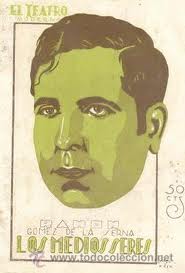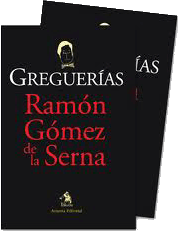Works of Ramon Gomez de la Serna
Ramon Gomez de la Serna was a writer with a strong personality. His work is made up of more than 100 titles, and his most significant literary creation was the greguería, which he invented in 1910. He was an enthusiast of anything new or innovative. Many of his works have been translated from Spanish into various languages, meaning that no matter where you are, you can always enjoy some of his work.
Ramon Gomez de la Serna - Works

He began his literary career by writing journalistic articles in several Spanish newspapers, to which he contributed on and off up until the dawn of the Spanish Civil War. His articles were easy to find, as they were present in almost all the magazines of the time, no matter what their size or importance was like. During the 20s, he starts to get some international recognition as a writer in France and Italy, and even Portugal, where he had a house for a while.
Being so enthusiastic about anything new, he began to write plays with a surrealist aesthetic. These surrealist writings would come to be a great influence for the Spanish surrealist film maker, Luis Buñuel. The best example of his plays is "Los medios seres", which was a failure in Madrid because the audience didn't understand what it was about, and they weren't too used to the avant-garde antics.
Although it's not his most popular aspect, Ramon Gomez de la Serna was an excellent essayist. His essays were key in introducing the vanguards in Spain, especially his book "Ismos". He was also interested in folkloric Madrid and found a way of renovating Costumbrism.

The greguerias are the most popular texts of Ramon Gomez de la Serna, because at the time they were a new genre. They are short humorous statements that are funny and profound at the same time. Gomez de la Serna cited various authors as being a great influence in his creation of the new genre, including people such as Shakespeare, Lope de Vega and Quevedo. The writer defines them as Humor + Metaphor = Greguería. They served to renovate the metaphor and also anticipated Surrealism. Metaphors were one of Gomez de la Serna's favourite literary tools, the best example of which can be found his book called "El Rastro", which is about the famous market in Madrid. In this book, the lost and forgotten items of the market are brought to life are saved by his evocative writing. The surprise effect the greguerías normally produce is achieved by:
- Visual association of two images: The moon is the porthole of night
- The reversal of a logical relation: Dust is full of old and forgotten sneezes
- The free association of bonded concepts: The pair of eggs we ate look like twins, but they're not even third cousins.
- The free association of conflicting concepts: The most important thing about life is not to die
As you can see, these phrases are meant to be funny, and aren't designed to carry some kind of meaning - just provide a humorous take on an aspect of everyday life. Ramon Gomez de la Serna actually dedicated a large part of his life to writing books in the new genre. Many were published in newspapers as well, helping to become one of the most well known writers in Spanish literature. These were very popular as they were short and simple, and appealed to everyone, especially as they were so original and contained so much of the writer's personal enthusiasm. Some of the gregurias works by Gomez de la Serna include "Greguerías" (1917), "Flor de greguerías" (1933), and "Total de greguerías" (1955), among many others.
His critical and sarcastic personality is most visible in his short stories and novels, especially in "El chalet de las rosas" (1923), an analysis on criminal behavior; or "El torero Caracho" (1926), which offers a grotesque vision of bullfighting. His erotic novels are also quite popular, especially "Senos" (1918) "La viuda blanca y negra" (1918), "La mujer de ámbar" (1927) and "La Nardo" (1930).
Ramon Gomez de la Serna was an enthusiastic biography writer as well, an interest which also spread to his own life, leading him to write a couple of volumes about his own memories, under the titles of "Automoribundia" and "Nostalgias de Madrid" (1955).

